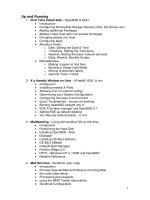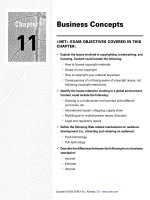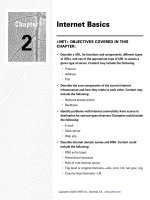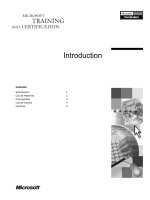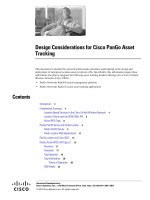Tài liệu Machine Considerations pdf
Bạn đang xem bản rút gọn của tài liệu. Xem và tải ngay bản đầy đủ của tài liệu tại đây (1.84 MB, 70 trang )
12
Machine Considerations
12.1 MACHINE FEEDBACK DRIVE CONSIDERATIONS
Machine Feed Drive Considerations for Resolver
Feedback
The usual configuration for resolver position feedback is to have the resolver
geared to the servo drive motor. Computer-aided design programs for
hydraulic drive sizing are based on the fact that the hydraulic resonance is
the predominant resonance in the servo loop. With electric drives the
mechanical time constant is not of prime consideration since it can be
compensated for with the drive compensation. These are two important
dynamic considerations with electric and hydraulic servo drives using
resolver feedback at the servo motor. Since the position feedback resolver is
close-coupled to the drive servo motor, all other mechanical resonances and
nonlinearities are excluded from the position servo loop. Recommendations
for the required indexes of performance (I.P.) are identical with those given
in Section 9.2.
Copyright 2003 by Marcel Dekker, Inc. All Rights Reserved
Machine Feed Drive Considerations for Direct Machine
Slide Position Feedback
The main reason that direct feedback could be used was the universal use of
the ‘‘soft servo’’ with its low position-loop g ain. By definition a soft servo
has a low position-loop gain of about 1 ipm/mil with no frequency breaks
below the servo bandwidth. The range of gains for the ‘‘soft servo’’ range
from 0.5 ipm/mil to 2 ipm/mil. As long as no resonances are within six times
the high end of this range (200 rad/sec or 32 Hz, Eq. [9.2-27]), it should be
possible to close the position loop and be stable.
As previously stated, if the feedback position transducer (resolver) is
located at the drive motor, any mechanical resonance in the machine will be
outside the servo loop. The effects of these mechanical resonances on the
closed-position loop will be reflected load disturbances.
However, if direct (e.g., Inductosyn-linear scales) position feedback is
to be used, the mechanical resonance in the mechan ical drive components
will be inside the position loop. For this situation, some guidelines,
recommendations, etc. should be put forth to prevent a situation where
direct feedback is used on a feed drive that will not be stable.
12.2 BALL SCREW MECHANICAL RESONANCES AND
REFLECTED INERTIAS FOR MACHINE DRIVES
As a constraint the lower limit on any resonance (hydraulic or mechanical)
inside the velocity loop should not be less than 200 rad/sec (Eq. [9.2-27]).
Likewise, the bandwith ðo
c
Þ of the closed velocity loop should not be
greater than one-third the lowest resonance in the servo loop, which is
usually the hydraulic resonance, o
h
, in hydraulic drives (Eq. [9.2-23]).
With the position loop, there may be a number of different mechanical
resonances. These resonances are outside the velocity loop but inside the
position loop. Considering the mechanical feed drive components, the one
of greatest concern is the drive screw axial resonance. This resonance will
probably be the predominant low mechanical resonance in a ball-screw feed
drive.
Typical values of ball screw stiffness are shown in the graph of Figure 1
for the variables of screw diameter and length. These values are based on
constant end bearing and ball nut stiffnesses. In actual practice, these would
be varied according to the screw diameter. In Figures 2 to 5, the ball screw
resonances are plotted for various screw diameters, lengths, and applied
load weights.
Resonances occurring outside the velocity loop and inside the position
loop will contribute phase shift to the open-position loop frequency-
Copyright 2003 by Marcel Dekker, Inc. All Rights Reserved
Fig. 1 Ball screw stiffness.
Fig. 2 Ball screw resonance.
Copyright 2003 by Marcel Dekker, Inc. All Rights Reserved
Fig. 3 Ball screw resonance.
Fig. 4 Ball screw resonance.
Copyright 2003 by Marcel Dekker, Inc. All Rights Reserved
response characteristics. To maintain the desired 458 phase margin for the
position loop, the resonances (such as the ball screw) should be sufficiently
high relative to the position-loop velocity constant ðK
v
Þ that they will not
reduce the phase margin. It is recommended practice that the lowest
resonance inside the position servo loop should be three times higher than
the minimum hydraulic resonance (200 rad/sec). If this practice is followed,
the reflected phase shift occurring at the velocity constant ðK
v
Þ from the
position loop resonance will not reduce the overall position-loop phase
margin. In actual practice this is somewhat academic because in large
machinery mechanical resonances do occur above and below 200 rad/sec. As
an index of performance (I.P.) it is recommended that the position loop
resonance (usually the ball screw) should be at least six times the position-
loop velocity constant ðK
v
Þ or greater than o
h
. (Refer to Section 9.2,
Eq. [9.2-22] to [9.2-28].)
A graph displaying this I.P. can be drawn (Figure 6) showing the
relation between position-loop velocity constant ðK
v
Þ and the lowest
allowable resonance in the position servo loop. For numerical controls
using the ‘‘soft servo’’ technique, it can be determined from the graph in
Figure 6 that resonances inside the position loop should, in general, be large
Fig. 5 Ball screw resonance.
Copyright 2003 by Marcel Dekker, Inc. All Rights Reserved
enough (at least 200 rad/sec) such that the resonance will not have a
detrimental effect on the drive.
For large machines where the velocity constant ðK
v
Þ usually cannot be
larger than 0.5 ipm/mil for reasons of stability, the lowest allowable
resonance (from Figure 6) could be as low as 50 rad/sec. For small machines
using the ‘‘soft servo’’ with velocity constants of 2 ipm/mil, the lowest
resonance in the position servo loop should not be less than 200 rad/sec.
Therefore, it is difficult to make an across-the-board recommendation with
changing velocity constants ðK
v
Þ from machine to machine.
One possible way to arrive at a recommendation is to assume that all
machines being built use position loop gains up to 2 ipm/mil, and therefore,
machines with ball screw resonances under 200 rad/sec cannot use direct
feedback. Another possibility, which is more practical, is to list the machines
with the recommended maximum allowable position servo loop gains ðK
v
Þ
that can be used with direct feedback. Since all axes on a machine must have
the same position loop gain, the machine axis with the lowest resonance will
be the determining factor in how low the position loop gain or velocity
constant ðK
v
Þ must be set.
Other Resonance Considerations
Additional mechanical resonances inside the position loop that may cause
stability problems should also be considered. Reflected structural resonances
Fig. 6 Lowest recommended resonance inside the position loop.
Copyright 2003 by Marcel Dekker, Inc. All Rights Reserved
due to large and sometimes limber machine structures may reflect their
resonances into the machine slide as the result of an antinode vibration.
Likewise, very large and heavy workpi eces placed on an otherwise stable
machine slide can cause stability problems when direct position feedback is
used.
Additionally, mechanical power transmission devices, such as ‘‘wound
up’’ gear trains, can be a source of stability problems when they are included
inside the position loop with direct slide position feedback. The gearbox can
have two types of problems. First, the amount of windup can vary causing a
change in spring rate that can cause instability. Second, any nonlinearity
such as backlash that occurs as a result of lost windup will result in an
unstable servo drive.
Reflected Inertias for Machine Drives
An important parameter to consider in sizing a machine servo drive is the
total inertia at the servo motor. The definition of inertia is the prop erty of a
body, by virtue of which it offers resistance to any change in its motion.
For an industrial machine slide the total reflected inertia to the servo
motor is made up of the reflected belt and pulley inertia (or gearboxes), the
reflected drive screw, and the reflected machine slide with its load weight.
Knowing the total inertia at the servo drive motor is a requirement for any
form of servo analysis or drive sizing.
The reflected inertia at the drive motor can be calculated as
J
reflected
¼
J
load
ðD
2
=D
1
Þ
2
(lb-in sec
2
Þ (12.2-1)
Where D
1
¼ diameter of the motor pulley or gear (in.)
D
2
¼ diameter of the load pulley or gear (in.)
A very important consideration in applying a drive to a machine axis is the
torque to inertia ratio. A mechanical equation for acceleration torque is:
T
T
¼ J a (lb-in.) (12.2-2)
Where J
T
¼ total inertia at the motor shaft (lb- in.)
a ¼ acceleration at motor shaft (rad=sec
2
)
Copyright 2003 by Marcel Dekker, Inc. All Rights Reserved
Equation (12.2-1) can be rearranged as
a ¼
T
J
(rad=sec
2
) (12.2-3)
Equation (12.2-3) is known as the torque to inertia ratio, and has important
significance. In a given drive application the machine will have a total inertia
(motor inertia plus reflected inertia) that exists by design. For productivity
requirements there will be a required acceleration. The question must now
be asked: Is there enough acceleration torque to meet these requ irements?
Quite often this becomes a critical drive-sizing problem providing enough
available current from the servo amplifier to accelerate the load required to
meet a productivity requirement?
For industrial servos using brushless DC drives there are two types of
motors to be considered. The brushless DC motor in general industrial
applications uses ceramic magnets. For high-performance applications, low
inertia motors are used. These motors use Neodymium-iron-boron (NdFeB)
magnet material or Samarium cobalt (SmCo) magnet material. A
comparison of torque to inertia ratios ðT/JÞ with various total inertia loads
is compared in Figure 7.
At small inertia loads the torque to inertia ratios for low inertia
motors are significantly higher than standard ceramic motors, which is an
indication that the low inertia motors are capable of higher performance
(and acceleration) with small total inertia loads. These curves also indicate
that the low inertia motors have a significant reduction in performance as
total load inertia increases. The standard ceramic magnet-type motors have
less reduction in performance with added total load inertia. The low inertia
drive is usually more expensive than the standard ceramic-magnet brushless
DC motor. For larger total inertia loads it is not economically justifiable to
use the low inertia type motor since performance will be compromised. If
high performance is a requirement, the reflected inertia load should be
reduced with a ratio if possible.
To further study the performance of brushless DC drives under
various inertial loads, a transient step response test will be made for a
velocity servo using a lag/lead compensation in the servo amplifier with a
gain of 1000 volts/volt. A more detailed analysis is presented in Chapter 14.
A 3-volt/1000 rpm tachometer feedback will be used. The block diagram for
this servo drive is shown in Figure 8. A simple velocity servo was chosen for
this analysis to minimize complexity.
A standard ceramic brushless DC motor and a low inertia brushless
DC motor will be used for this analysis. The motor parameters are identified
as the following:
Copyright 2003 by Marcel Dekker, Inc. All Rights Reserved
MOTOR STANDARD MOTOR LOW INERTIA MOTOR
(Kollmorgan M607B) (Kollmorgan EB606B)
K
T
¼ 9.9 lb-in./A 9.9 lb-in./A
K
e
¼ 0.3734 v-sec/rad 0.3734 v-sec/rad
R
motðl ÀlÞ
¼ 0.14 ohm 0.14 ohm
SR
motðl ÀlÞ
0.189 ohm 0.189 ohm
SR
motðphaseÞ
¼ 0.0945 ohm 0.0945 ohm
L
lÀl
¼ 0.0038 henry 0.0038 henry
J
mot
¼ 0.1872 lb-in sec
2
0.02688 lb-in sec
2
t
e
¼
L
ðl ÀlÞ
SR
motðl ÀlÞ
¼
0:0038
0:189
¼ 0:02 sec 0:02 sec (12.2-4)
t
m
¼
SR
motðphaseÞ
J
tot
K
eðphaseÞ
K
T
(12:2-5)
J
total
¼ J
mot
þ J
reflected
(12.2-6)
Transient responses for a multiplicity of load inertias are shown in Figures 9
to 16. In this analysis it is assumed that each drive will be analyzed with
identical inertia loads as if a machine axis was being tested with a standard
brushless DC motor and then tested again with a low inertia motor.
Load inertia Standard motor Low inertia motor
(lb-in sec
2
) transient responses transient responses
1 X MOTOR Fig. 9 Fig. 10
0.2 Fig. 11 Fig. 12
0.8 Fig. 13 Fig. 14
2.0 Fig. 15 Fig. 16
A ceramic-magnet brushless DC servo motor will have some reduction in
servo bandwidth with added load inertia (Figures 9, 11, 13, and 15), but
these drives are tolerant of added load inertia without having to be
recompensated. Rare earth brushless DC drives are load inertia sensitive
(Figures 10, 12, 14, and 16). For br ushless DC servo drives with ceramic-
magnet armatures, a ratio of approximately four times reflected load inert ia
to the motor armature can be tolerated. For low-inertia brushless DC
motors it is recommend ed that the reflected load inertia matc h the motor
inertia. Since these motors are used for high-performance applications, it is
advisable not to reduce the servo bandwidth with inertia mismatch ratios
larger than one. Reflected load inertias can be computed as follows:
Copyright 2003 by Marcel Dekker, Inc. All Rights Reserved
Reflected Machine Slide Inertia
J
slide
¼ W6ðL=NÞ
2
60:0000656 ðlb-in sec
2
Þ (12.2-7)
where: W ¼ total machine slide and load weight (lb)
L ¼ ball screw lead (in./rev)
N ¼ drive ratio
Fig. 7 Torque to inertia ratio comparisons.
Copyright 2003 by Marcel Dekker, Inc. All Rights Reserved
Fig. 8 Velocity servo block diagram.
Fig. 9 Transient step response with a 1 6 inertia load for a standard ceramic-
magnet motor.
Copyright 2003 by Marcel Dekker, Inc. All Rights Reserved
Reflected Drive Screw Inertia
The drive screw inertia (without threads) reflected to the servo motor can be
calculated from Eq. (12.2-1).
J
screw
¼ X
1
À½ðX
2
þ X
3
Þ6X
4
6X
5
(lb-in sec
2
) (12.2-8)
where: DIA ¼ screw diameter (in.)
LGTH ¼ screw length (in.)
Ball dia ¼ diameter of the balls in the drive screw nut (in.)
Fig. 10 Transient step response with a 1 6 load inertia for a low inertia motor.
Copyright 2003 by Marcel Dekker, Inc. All Rights Reserved
where:
X
1
¼ðDIA
4
6LGTH60:000072Þ = N
2
(12.2-9)
T
2
¼ATN½L=ð3:141596DIAÞ (12.2-10)
X
2
¼ðball dia=2Þ
4
60:10941 (12.2-11)
X
3
¼½ð3:14159=26ball dia
2
Þ=2
6½DIA=2 Àð0:42446ðball dia=2Þ
2
Þ (12.2-12)
X
4
¼0:0046046½DIA=2 Àð0:42446ball dia=2Þ
6½1= cosðT
2
Þ (12.2-13)
X
5
¼LGTH=ðL6N
2
Þ (12.2-14)
The reflected ball screw inertia (including threads) can be calculated as
follows:
Fig. 11 Transient step response with a 0.2 lb-in sec
2
inertia load for a standard
ceramic motor.
Copyright 2003 by Marcel Dekker, Inc. All Rights Reserved
J
screw
¼
DIA
4
6LGTH67:2610
À5
N
2
(lb-in sec
2
) (12.2-15)
Pulley Inertias
Ratio ¼screw pulley diameter/motor pulley diameter
Woods pulleys, 3-inch pulley inertias (lb-in sec
2
)
No. Pulley no. Approx. diameter Inertia
1 16H300 2.39 0.0082
2 18H300 2.71 0.013579
3 19H300 2.86 0.017198
Fig. 12 Transient step response with a 0.2 lb-in sec
2
inertia load for a low inertia
motor (equivalent to a 10 6 inertia load).
Copyright 2003 by Marcel Dekker, Inc. All Rights Reserved
No. Pulley no. Approx. diameter Inertia
4 20H300 3.03 0.02145
5 21H300 3.18 0.0263
6 22H300 3.35 0.02417
7 24H300 3.66 0.03189
8 26H300 3.98 0.04275
9 28H300 4.30 0.05909
10 30H300 4.62 0.0780
11 32H300 4.94 0.09990
12 36H300 5.58 0.160
13 40H300 6.21 0.2249
14 44H300 6.85 0.33489
15 48H300 7.48 0.47042
16 60H300 9.36 0.8005
17 72H300 11.30 1.4818
Fig. 13 Transient step response with a 0.8 lb-in sec
2
inertia load for a standard
ceramic-magnet motor.
Copyright 2003 by Marcel Dekker, Inc. All Rights Reserved
No. Pulley no. Approx. diameter Inertia
18 84H300 13.21 2.5103
19 96H300 15.12 4.0924
20 120H300 18.94 8.6475
21 156H300 24.67 21.798
Woods pulleys, 2-inch pulley inertias (lb-in sec
2
)
No. Pulley no. Approx. diameter Inertia
1 16H200 2.39 0.004066
2 18H200 2.71 0.00802
3 19H200 2.86 0.01246
4 20H200 3.03 0.01527
5 21H200 3.18 0.01913
Fig. 14 Transient step response with a 0.8 lb-in sec
2
inertia load for a low inertia
motor.
Copyright 2003 by Marcel Dekker, Inc. All Rights Reserved
No. Pulley no. Approx. diameter Inertia
6 22H200 3.35 0.01869
7 24H200 3.66 0.02488
8 26H200 3.98 0.03342
9 28H200 4.30 0.04555
10 30H200 4.62 0.05987
11 32H200 4.94 0.07841
12 36H200 5.58 0.12445
13 40H200 6.21 0.17903
14 44H200 6.85 0.26439
15 48H200 7.48 0.37604
16 60H200 9.36 0.54131
17 72H200 11.30 1.1520
Fig. 15 Transient step response with a 2 lb-in sec
2
inertia load for a standard
ceramic motor (equivalent to a 10 6 inertia load).
Copyright 2003 by Marcel Dekker, Inc. All Rights Reserved
No. Pulley no. Approx. diameter Inertia
18 84H200 13.21 1.9541
19 96H200 15.12 3.2206
20 120H200 18.94 6.7934
21 156H200 24.67 17.3840
In addition to the reflected inertias for a linear machine slide, other
configurations are given for a belt drive (Figure 17), a rack drive (Figure 18),
a rotary drive (Figure 19), and a rotary drive with a ring gear and pinion
(Figure 20) using a ring gear. In selecting the units to express inertias the
user should be consistent throughout all calculations. A rotary conversion
table is included as Figure 21.
Fig. 16 Transient step response with a 2 lb-in sec
2
inertia load for a low inertia
motor.
Copyright 2003 by Marcel Dekker, Inc. All Rights Reserved
where:
N ¼
N
OUT
N
IN
N
IN
< N
OUT
L ¼ lead of belt ¼
in
rev
J
REF
¼
WT½lb
386½in:=sec
2
6
L
N
(in./rev)6(rev=2p rad)
2
J
REF
¼ WTðL=NÞ
2
0:0000656 (lb-in sec
2
)
where:
L ¼ lead of rack and pinion ¼
in
rev
J
REF
¼ WTðL=NÞ
2
0:0000656 (lb-in sec
2
)
Fig. 18 Reflected inertia for a rack drive.
Fig. 17 Reflected inertia for a belt drive.
Copyright 2003 by Marcel Dekker, Inc. All Rights Reserved
where:
N ¼
N
OUT
N
IN
N
IN
< N
OUT
J
REF TO MOTOR
¼
WT6RADIUS
2
263866RATIO
2
(lb-in sec
2
)
where:
N ¼
N
OUT
N
IN
N
IN
< N
OUT
Ratio of table ring gear/pinion ¼lead ¼revolutions of table/revolu-
tions of pinion.
J
REF TO MOTOR
¼
WT6RADIUS
2
263866ðRATIO6LEADÞ
2
(lb-in sec
2
)
WT ¼ lbs
Lead ¼ ln=rev
N ¼ ratio
Radius ¼ in:
Fig. 19 Reflected inertia for a rotary drive.
Fig. 20 Reflected inertia for a rotary drive using a ring gear.
Copyright 2003 by Marcel Dekker, Inc. All Rights Reserved
12.3 DRIVE STIFFNESS
Machine feed drives should have sufficient static stiffness to be insensitive to
load disturbances. In addition, a feed drive in a contouring numerical
control system must remain stationary or clamped when not in motion. Thi s
is called ‘‘servo clamping.’’ Also during the standstill period, the axis at rest
must resist the load disturbances caused by the cutter reaction forces.
The static stiffness of a feed servo drive is the equivalent spring
stiffness of the drive measured at the output. The stiffness can be measured
at several different places, such as the drive motor shaft, at the drive input to
the ball screw, or at the machine slide. When the stiffness is measured at the
rotary components the units of measurement are lb-in./rad. When the
stiffness is measured at the machine slide the unit of measurement is lb/in.
Drive stiffness, measured as the machine slide displacement in inches caused
by a displacement force in pounds, increases as the square of the ratio and
with the fineness of the lead of the screw. Therefore, in sizing a servo drive, it
is important to consider the benefits of using a drive ratio and small lead
(in./rev).
Fig. 21 Rotary inertia conversion table.
Copyright 2003 by Marcel Dekker, Inc. All Rights Reserved
Fig. 22 Hydraulic servo-drive stiffness.
Copyright 2003 by Marcel Dekker, Inc. All Rights Reserved
Fig. 23 Electric servo-drive stiffness.
Copyright 2003 by Marcel Dekker, Inc. All Rights Reserved
It is possible to have a stiffness measurement for each type of feedback
servomechanism. For example, a velocity servo drive with tachometer
feedback would have a velocity stiffness with the units of lb-in./rad/sec. For
the purpose of this discussion the drive stiffness is derived for the case of a
positioning servo drive with an internal tachometer loop.
To illustrate the engineering analysis of the static drive stiffness, two
cases of direct slide positioning are considered: a hydraulic servo drive and
an electric servo drive. Servo-drive stiffness equations for both hydraulic
and electric drives are summarized in Figures 22 and 23. The derivation for
the stiffness of the hydraulic servo drive is followed by the electric servo-
drive stiffness derivation.
Hydraulic Servo-Drive Stiffness with Direct Feedback
A mechanical model of a machine feed slide is shown in Figure 24. It is
assumed that the drive screw spring rate is represented by G
T
. The
machine’s slide inertia reflected to the drive screw plus the inertia of the
drive screw is represented by J
L
. The load forces acting on the machine slide
are reflected to the drive screw as T
L
. The friction forces of the machine slide
are reflected to the drive screw and represented by B
L
. The mechanical drive
ratio is represented by N.
Fig. 24 Machine slide free-body diagram.
Copyright 2003 by Marcel Dekker, Inc. All Rights Reserved
The equations for the mechanical model of Figure 24 are written in the
following steps:
y
1
¼
y
m
N
T
1
¼ NT
m
T
1
¼ G
T
ðy
1
À y
o
Þ
For dynamic equilibrium we have:
J
L
s
2
y
o
þ B
L
sy
o
¼ T
L
þ G
T
ðy
1
À y
o
Þ (12.3-1)
ðJ
L
s
2
þ B
L
s þG
T
Þy
o
¼ T
L
þ G
T
y
1
(12.3-2)
ðJ
L
s
2
þ B
L
s þG
T
Þy
o
¼ T
L
þ
G
T
N
y
m
(12.3-3)
From the basic torque relationship,
T
m
¼
T
1
N
¼
G
T
N
ðy
1
À y
o
Þ (12.3-4)
T
m
¼
G
T
N
y
m
N
À y
o
(12.3-5)
T
m
¼
G
T
N
2
y
m
À
G
T
N
y
o
(12.3-6)
From Eq. (12.3-3) the output position of the drive screw is
y
o
ðsÞ¼
T
L
þ
G
T
N
y
m
ðJ
L
s
2
þ B
L
s þG
T
Þ
(12.3-7)
An additional set of e quations can be written for the hydraulic drive. The
basic flow equations are developed as a first step from Figure 25, using the
terms
Q
1
; Q
2
¼ hydraulic oil flow in and out (in:
3
=sec)
P
1
; P
2
¼ hydraulic pressure (psi)
K
C
¼ hydraulic valve pressure coefficient (in:
3
=sec Àpsi)
K
v
¼ hydraulic valve gain (in:
3
=sec-in:)
X
v
¼ hydraulic valve displacement (in.)
K
C
¼À
qP
L
¼À
DQ
DP
L
(12.3-8)
Therefore
P
L
¼ DP
1
À DP
2
(12.3-9)
Copyright 2003 by Marcel Dekker, Inc. All Rights Reserved

